
Table of Contents
There are living souls which, by the energeia of their love, communicate life to everything that comes near them. And there are souls which, beneath an external appearance of life, are dead, and congeal into their own death everything they come near.
Henry Corbin
Why does Dante describe the Inferno as a real place?
What secret society did Dante belong to?
What is the Dante code?
What is his connection to the origin of tarot cards and the arrival of the Antichrist?
What was his secret connection to militant Islamic sects?
Did Vergil, his guide to the Inferno, have supernatural powers?
Why did Dante portray his spiritual mentor as suffering the torments of hell?
What was Dantes secret connection to the Knights Templar?
What was the mysterious cult statue found in the crypt of the Temple in Paris when it was finally ransacked?

A Division of Simon & Schuster, Inc.
1230 Avenue of the Americas
New York, NY 10020
www.SimonandSchuster.com
Drawing of boar and of Templar graffiti copyright 2013 by Tabitha Booth.
Copyright 2013 by Mark Booth
Originally published in 2013 in Great Britain by Quercus Editions Ltd.
All rights reserved, including the right to reproduce this book or portions thereof in any form whatsoever. For information address Atria Books Subsidiary Rights Department, 1230 Avenue of the Americas, New York, NY 10020.
First Atria Books ebook edition June 2013
 and colophon are trademarks of Simon & Schuster, Inc.
and colophon are trademarks of Simon & Schuster, Inc.
The Simon & Schuster Speakers Bureau can bring authors to your live event. For more information or to book an event contact the Simon & Schuster Speakers Bureau at 1-866-248-3049 or visit our website at www.simonspeakers.com.
ISBN 978-1-4767-5311-9
Born in Blood
Dante Alighieri was born in 1265 in the region we know today as Tuscany. We know little about the ancient Etruscan civilization which lent its name to Tuscany because the Etruscans were all but wiped out by the Romans. It is known, however, that an Etruscan town once stood on the hill where today Fiesole overlooks Florence. According to legend, it was in 72 b.c., after Julius Caesar had crushed the Etruscans in battle in a lovely valley full of lilies, that the town itself was founded and given the name Firenze, meaning flowering or flourishing.
Dante called Florence Romes most beautiful daughter. There is a strange quality to the light surrounding it like a golden aura. The art, architecture, and literature of Florence have illumined our inner lives and fired our imaginations as much as the creations of any city.
Today Florence is overcrowded and noisy but still a life-affirming place, where almost every turn reveals a beautiful and usually ancient vista to delight the eye. I have an Irish friend who works at the European Institute in Fiesole and is something of a bon viveur, erudite and knowledgeable in all sorts of areas, including the location of the best little trattoria. Is there a better place to taste the sweetness of being alive than the banks of the Arno on a warm autumn evening when you are ambling along, slightly drunk, and the sun is no longer blazingly hot but the earth, which has been baking over several months, is warming the air and you are on your way to dinner?
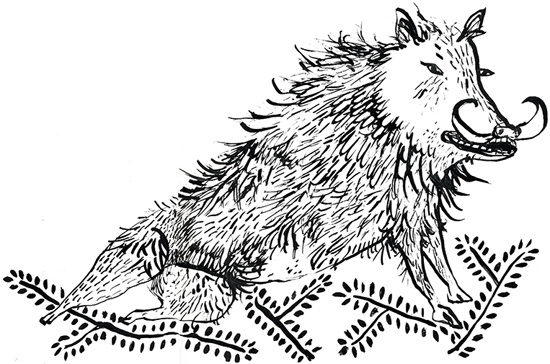
There is a statue of a wild boar in the Loggia del Mercato in the middle of Florence which is a famous symbol of the city. In mythology, Adonis, a lover of Venus, was gored to death by a boar, making it also a symbol of love gone wrong and appropriate for a life of Dante. (Drawing by Tabitha Booth)
But Florence has always had a dark side. For a long time its emblem was a white lily on a field of blood. The first patron saint of the city was Reparata, a little girl who was tortured to death at the age of ten or eleven. As we shall see shortly, Florence in the time of Dante was a place where secret societies intrigued and sometimes openly clashed, and where hidden, heretical, sometimes occult beliefs led to maiming, torture, mass murder, and even cannibalism.
In the eighties my Irish friend used to weird us out with the latest stories of il Mostro, the Monster of Florence, a serial killer who preyed on courting couples and specialized in sexual mutilation. Il Mostro seemed to have almost supernatural powers of stealth and cleverness which enabled him to evade capture. When a culprit was eventually put on trial, Thomas Harris sat through the court sessions, assembling the character of Hannibal Lecter. Anyone who has read The Monster of Florence , a thrilling nonfiction account by Douglas Preston and Mario Spezzi; or followed the labyrinthine conspiracy that led to Gods banker, Roberto Calvi, being found hanged under London Bridge; or, more recently, followed the murder trial of Amanda Knox, will feel confident that special interest groups and secret societies are still at work in the higher levels of Italian society.
As a child, Dante would have gazed up at the dizzyingly high ceilings of the Baptistery of St. John, which sits right in the geometric center of Florence and where he himself had been baptized in his first year. He would no doubt have contemplated, too, the bloodred porphyry pillars at the entrance to the Baptistery. According to legend, these were made from the compacted and ossified flesh of the Titans, the giant enemies of the gods who had been buried underground as a punishment. It was also said that if you polished the pillars at special times of year, you could see the forms of spirits in themand communicate with them too.
In local lore Florence thronged with supernatural beings. The bronze statue of a faun in a piazza next to the Ponte Vecchio, up against the wall in the Via Guicciardini, was said to have been seen dancing on St. Johns Eve. Just as in English folklore, fairies in Italy are sometimes thought to be the spirits or folk memories of extinct aboriginal peoples, and fairies wearing ancient costumes were reportedly seen in the vicinity of the Etruscan ruins on the hill at Fiesole. By the great Etruscan walls, still pretty much intact at the time of Dante, there were small hills made up of vaults and low walls which had gradually been covered over by earth and grass, and these were known locally as the dens of the fairies.
There was also a popular story of some local monks who had sung a hymn from the old religion in praise of Bacchus and been punished by being given the ears of an assa tale that may remind us both of A Midsummer Nights Dream and, indeed, of Shakespeares source, The Golden Ass of Apuleius, to which we will return later, as it is one of the few accounts we have of the underground initiation ceremonies in the ancient world.
Dante may well have also heard the local tale that was said to have originated with a cabbage seller who had a stall outside the Palazzo della Cavalleria. According to this old widow, there were underground passageways and chambers beneath the palazzo where eminent persons she knew to be witches and wizards gathered to perform their ceremonies. If a witch, or fata , died without an apparent successor, the group would meet at night to discuss the problem. Sometimes she saw finely dressed gentlemen and ladies who were not part of the secret society enternever to be seen again. There were rumors of a swinging contraption built into the entrance gate which meant that it actually moved. When you went to exit, thinking you were about to step into the safety of the street, the contraption suddenly swung around and you were propelled into a pit.
Next page
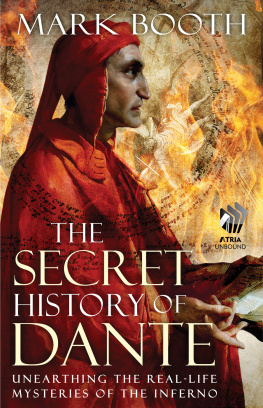
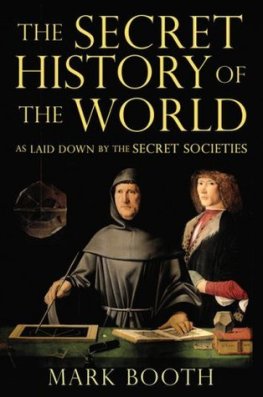

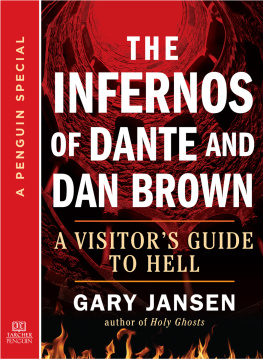
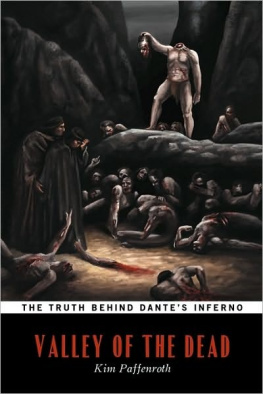
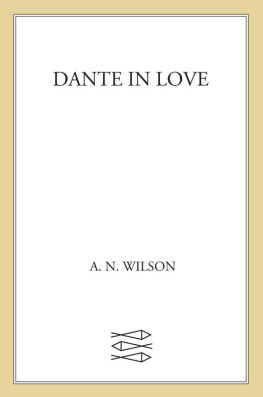

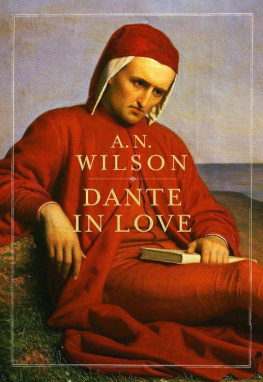


 and colophon are trademarks of Simon & Schuster, Inc.
and colophon are trademarks of Simon & Schuster, Inc.